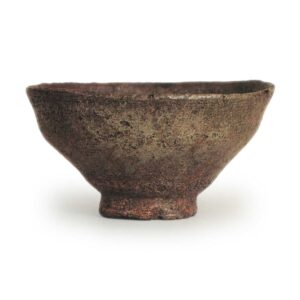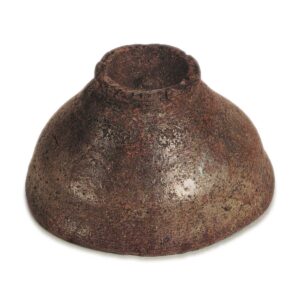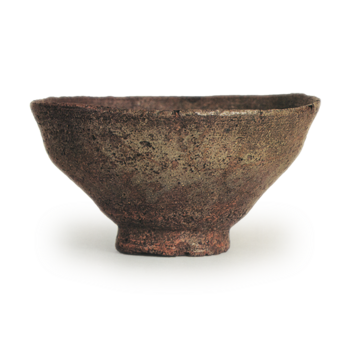

Held in the Matsunaga Memorial Museum
Height: 7.3-7.8cm
Diameter: 14.0-14.3cm
Outer diameter of foot ring: 5.5-5.7cm
Height of foot ring: 1.1-1.3cm
The name “Hakua” is thought to have been given by Matsudaira Fumai, and the glaze that covers the outside of the bowl is probably what gave it its name, as the white-tinged lead glaze on some parts of the bowl resembles the appearance of a shower of white rain.
Like most persimmon-shaped tea bowls, the glaze is thin and unevenly applied to the surface, but because the clay is a reddish-brown color, the contrast between the reddish-brown clay and the bluish-tinged glaze is vivid.
The foot ring is slightly larger than the diameter of the bowl, and it has been clearly and deeply carved out. The tatami mat is thick, and the inside has been carved quite deeply. As a result, the hood is also high, and the overall shape of the foot ring is full of strength. The rise from the foot ring to the body of the bowl is extremely high compared to other bowls, and it has a unique shape. Nevertheless, as promised, there is one bend at the foot and one at the body, but the distance between the foot and the body is quite long, and the body is slightly constricted inward, so the overall shape appears tall and thin. The rim of the mouth is slightly turned outwards, and the rim of the mouth is slightly turned inwards.
Because of the high waist, the inside of the bowl is quite deep, and two distinct lines of the potter’s wheel mark can be seen on the inside, adding a sense of depth to the bowl. As mentioned earlier, the glaze has a rich variety of colors due to the vivid redness of the clay. This tea bowl is probably the most richly decorated of the Kakiemon tea bowls in my collection, after the Otsu and Kyogoku tea bowls.
The glaze is extremely thin from the outer foot to the foot ring, so the reddish brown clay surface is clearly visible, and the color is reddish. From the waist to the rim, the pale greenish a light greenish-blue glaze is applied in patches, and in some places it is a strong lead color, while in others it has a greenish appearance, as if moss were growing on the rocks. Furthermore, the clay surface appears in places in a dark iron color, and there are various changes in the subdued color tones. The inside of the cup is covered in dark iron-colored glaze, and the view is not as rich as the outside, but it has a deep sense of the subtle and profound that is very suitable for wabi-cha.
There is a large crack from the rim to the side of the foot, and there are also quite a few cracks on the outside, but the lacquer repairs are not noticeable and are not a concern.
According to the “Unshu Meibutsu Ki” (Famous Things of Unshu), in the “Upper Section” it says “Heta Hakutsu Tani Gon 500 ryou”, and although it is not clear when it became Fumai’s property, it is known that he purchased it from the dealer Tani Gon for the sum of 500 ryou. It was passed down from the Matsudaira family to Hara Sankei of Yokohama, and the calligraphy on the outer box, “obi”, is in Sankei’s handwriting, and there is also a note on the underside of the lid, “Formerly owned by Fumai, Sankei (signature)”. The inner box is a fairly old-fashioned box, and on the front of the lid are the two characters “Hakuyu” in red lacquer. This is said to be written by Fumai himself. After the Pacific War, it was passed from the Hara family to the possession of Matsunaga Ji-an, along with works by Kenzan such as “Hanatsubaki-zu”.



